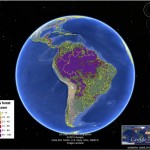 Citizen scientists have turned their hand to all manner of things in recent years, from helping medical research to hunting asteroids.
Citizen scientists have turned their hand to all manner of things in recent years, from helping medical research to hunting asteroids.
A recent project has had them help one of the most important environmental issues on the planet. When you talk of the environment, it’s perhaps quite common to think of climate change or energy, maybe pollution or agriculture.
One issue that seldom seems to get the attention it deserves is deforestation, which given its impact on both the biodiversity of the planet and on climate change, is far from ideal.
A good place to start when discussing deforestation is a thorough understanding of just what levels of forestation the planet currently enjoys. It’s a task that is often easier said than done.
The Geo-Wiki team has been setup by the International Institute for Applied System Analysis (IIASA) to try and provide a more accurate view on the world’s forests.
The output from their project has recently been published as a series of maps in the Remote Sensing of the Environment journal, but are also freely available on the Geo-Wiki website (linked above).
Unifying forestry data
Whilst there is substantial data out there about forestation around the world, there isn’t really strong agreement between the various sources. Hence the crowd were deployed to make things better.
“The new maps rely on a combination of recent multisensory remote sensing data, statistics, and crowdsourcing,” the project team say. “By combining different data sources, and incorporating the input of trained citizen scientists, we were able to produce new maps that are more accurate than any existing data source.”
The project has produced two global maps, both of which are at 1 kilometer resolutions. The maps aim to provide a satisfying compromise between global coverage and local detail.
The first map uses eight different data sources and relied on the citizen science network to validate the land cover classifications after analyzing high-res satellite imagery.
When the project team analyzed this analysis, they found that the work was generally more reliable and accurate than existing sources for both forest location and forest cover estimations.
The second map utilized forest statistics from the Food and Agriculture Organization. The aim of the second map is to provide a useful resource for economic modeling, as well as a basis for climate change negotiations.
The two maps are used to compare results from the two sources, and therefore highlight where there is potential discrepancies in reporting.
Tools for policy makers
The hope is that the new maps won’t just be valuable for researchers but also for policy makers who are reliant upon accurate forest data for their decision making.
An example of how the new maps can help comes via the EU’s biofuel target, which varies considerably depending on which forest data is used in the decision process.
The Geo-Wiki team are also working on other forms of map, including ones on global cropland and land cover, both of which were published earlier this year. The team are firm supporters of the value of citizen scientists in such endeavors.
“These new maps just go to show that regular people, in their free time, can contribute to top quality research,” they say.
They hope to tap into the network further to continue improving knowledge of land cover and provide more robust data for researchers and policy makers around the world.
Cool project. Like it.